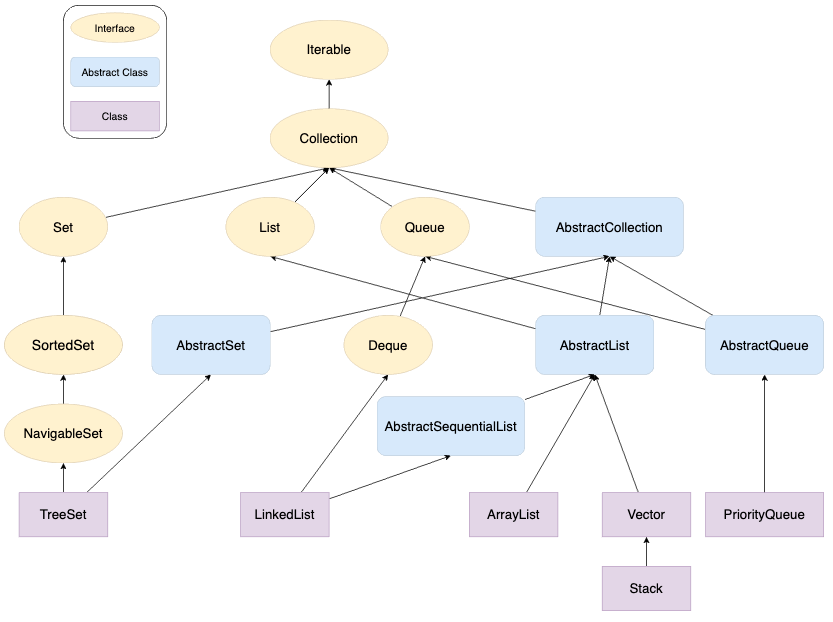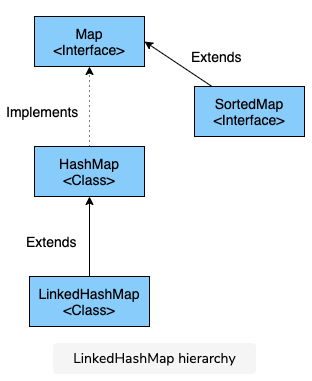Java Collections¶

NB: Course is started with educative.io version and will be expanded the list to include more collection
Collection v.s. Collections¶
- Collection is an interface, collections is a class.
- A Collection interface provides the standard functionality of a data structure to List, Set, and Queue. However, the Collections class provides the utility methods that can be used to search, sort, and synchronize collection elements.
ArrayList¶
- Default size is 10. Java 8 lazy allocation, 0 on creation, resize to 10 on adding.
- The capacity is checked when added, it reallocate strategy is create n + n / 2 + 1.
Basic Methods¶
List.add(E e)List.add(int index, E e)List.addAll(Collection c)List.addAll(int index, Collection c)List.get(int index)List.size()List.remove(int index), e.g.list.remove(2);List.remove(Object o), e.g.list.remove(new Integer(2));List.removeRange(int fromIndex, int toIndex)List.removeAll(Collection<?> c)List.clear()List.replaceAll(UnaryOperator<E> operator), e.g.list.replaceAll((element) -> element.toUpperCase());List.set(int index, E e)List.contains(Object o)List.indexOf(E e)List.lastIndexOf(E e)
import java.util.ArrayList;
import java.util.List;
public class ArrayListDemo {
List list = new ArrayList();
list.add(1);
list.add(2);
list.add(3);
System.out.println(list);
list.add(4);
System.out.println(list);
list.add(1, 50);
System.out.println(list);
List newList = new ArrayList();
newList.add(500);
newList.add(600);
System.out.println(newList);
list.addAll(newList);
System.out.println(list);
list.addAll(1, newList);
System.out.println(list);
}
// output:
// [1, 2, 3]
// [1, 2, 3, 4]
// [1, 50, 2, 3, 4]
// [1, 50, 2, 3, 4, 150, 160]
// [1, 150, 160, 50, 2, 3, 4, 150, 160]
Using an Iterator¶
Interator<Integer> iter = List.iterator();iter.hasNext()iter.next()iter.remove()iter.forEachRemaining(Consumer<? super E> action)- Once a interator is created, we can not modify the List while interating elements.
Iterator<Integer> iter = list.iterator();
// remove a element WRONG WRONG
while (iter.hasNext()) {
int next = iter.next();
if (next == 30) {
list.remove(new Integer(30));
}
}
// CORRECT
while (iter.hasNext()) {
int next = iter.next();
if (next == 30) {
iter.remove();
}
}
// add an element WRONG WRONG
Iterator<Integer> iter = list.iterator();
list.add(10);
while (iter.hasNext()) {
System.out.println(iter.next());
}
Using an ListIterator¶
ListIterator<Integer> listIterator = list.ListIterator();List.hasNext();List.next();List.hasPrevious();List.previous();List.nextIndex();List.previousIndex();List.remove();, can only be made for each call tonext()orprevious().List.set(E e);, replace the element returned bynext()orprevious().List.add(E e);, add before the element returned bynext().
Sort ArrayList¶
Collections.sort(List<T> list), typeTmust implement theComparableinterface.List<Integer> sortedList = list.stream().sorted().collect(Collectors.toList());, Java 8.Collections.sort(list, Collections.reverseOrder());List<Integer> sortedList = list.stream().sorted(Comparator.reverseOrder()).collect(Collectors.toList());, Java 8.
Comparable Interface¶
public class Vehicle implements Comparable<Vehicle> {
String brand;
Integer makeYear;
public Vehicle(String brand, Integer makeYear) {
super();
this.brand = brand;
this.makeYear = makeYear;
}
@Override
public int compareTo(Vehicle o) {
return this.makeYear - o.makeYear;
// We can also use the compareTo() method of the Integer class.
//return this.makeYear.compareTo(o.makeYear);
}
}
Comparator Interface¶
Collections.sort(List<T> list, Comparator<? super T> c).- Comparator interface has a method,
compare(T o1, T o2).
// BrandComparator.java
import java.util.Comparator;
public class BrandComparator implements Comparator<Vehicle> {
@Override
public int compare(Vehicle o1, Vehicle o2) {
return o1.brand.compareTo(o2.brand);
}
}
// use the comparator in code
Collections.sort(list, new BrandComparator());
// alternatively use anonymous comparator class
Collections.sort(list, new Comparator<Vehicle>() {
@Override
public int compare(Vehicle o1, Vehicle o2) {
return o1.brand.compareTo(o2.brand);
}
});
// Use Java 8 lambda comparator (functional style)
Collections.sort(list, (o1, o2) -> o1.brand.compareTo(o2.brand));
LinkedList¶

- LinkedList class implement both the
ListandDequeinterfaces. -
LinkedList definition
private static class Node<E> { E item; Node<E> next; Node<E> prev; Node(Node<E> prev, E element, Node<E> next) { this.item = element; this.prev = prev; this.next = next; } } // construct a LinkedList List<Integer> list = new LinkedList<Integer>(); // construct a LinkedList with existing list List<Integer> list = new LinkedList<Integer>(oldList); -
LinkedListoperation methods
// add elements
LinkedList.add(E e)
LinkedList.addFirst(E e)
LinkedList.addLast(E e)
LinkedList.add(int index, E e)
LinkedList.addAll(Collection c)
LinkedList.addAll(int index, Collection c)
// fetch elements
LinkedList.getFirst()
LinkedList.getLast()
LinkedList.get(int index)
// remove elements
LinkedList.removeFirst()
LinkedList.removeLast()
LinkedList.remove(int index)
LinkedList.remove(Object 0)
// sorting
Collections.sort(linkedList);
CopyOnWriteArrayList¶
-
creating a
CopyOnWriteArrayListprivate transient volatile Object[] array; public CopyOnWriteArrayList() { setArray(new Object[0]); } final void setArray(Object[] a) { array = a; } List list = new CopyOnWriteArrayList(); // using an existing array public CopyOnWriteArrayList(E[] toCopyIn) { setArray(Array.copyOf(toCopyin, toCopyIn.length, Object[].class)); } -
inserting elements into a
CopyOnWriteArrayListCopyOnWriteArrayList.add(E e) CopyOnWriteArrayList.add(int index, E element) CopyOnWriteArrayList.addAll(Collection c) CopyOnWriteArrayList.addIfAbsent(E e) CopyOnWriteArrayList.addAllAbsent(Collection c)
CopyOnWriteArrayList internal¶
- Using a reentrant lock
final transient ReentrantLock lock = new ReentrantLock(); - Steps: writing thread aquire the by
lock.lock(); make a copy of the data with size oflength + 1; add the element at the end of the copied data; point to the new data; release the lock.
Interation¶
- Using
forEach(Consumer<? super E> action). -
Using
iterator(). No synchronization is needed while traversing the iterator because the iteration is being done on a snapshot.import java.util.Iterator; import java.util.List; import java.util.concurrent.CopyOnWriteArrayList; public class CopyOnWriteArrayListDemo { public static void main(String args[]) { List<String> list = new CopyOnWriteArrayList<>(); list.add("Apple"); list.add("Banana"); list.add("Orange"); //Created an iterator Iterator<String> itr = list.iterator(); //Adding elements after creating iterator. ConcurrentModificationException will not be thrown. list.add("Papaya"); //Iterating the list through the iterator that was created earlier. Papaya will not be present. while(itr.hasNext()) { System.out.println(itr.next()); } System.out.println("Again getting the iterator"); //Again creating the iterator. This time papaya will be present. itr = list.iterator(); while(itr.hasNext()) { System.out.println(itr.next()); } } } -
iterator()ofCopyOnWriteArrayListclass doesn't supportremove()method. We can directly remove a element while iterating throught the list.import java.util.Iterator; import java.util.List; import java.util.concurrent.CopyOnWriteArrayList; public class CopyOnWriteArrayListDemo { public static void main(String args[]) { List<String> list = new CopyOnWriteArrayList<>(); list.add("Apple"); list.add("Banana"); list.add("Orange"); //Created an iterator Iterator<String> itr = list.iterator(); while(itr.hasNext()) { System.out.println(itr.next()); list.remove("Orange"); } System.out.println("Again creating the iterator"); //Created an iterator itr = list.iterator(); while(itr.hasNext()) { System.out.println(itr.next()); } } }
Sets¶
- Creating a HashSet
Set<Integer> set = new HashSet<>();. -
Operations
Set.add(E e) Set.contains(E e) Set.remove(Object o) // return true if element in the set, false if not in the set. Set.clear() Set.isEmpty() -
Iterate a
Set, usingforloop,Iterator, andforEach(). HashSetis not ordered, it can not be sorted.
TreeSet¶

TreeSetdoesn't allow duplicate elements.TreeSetdoesn't allow null elements.TreeSetstore elements in ascending order.HashSetV.S.TreeSet- allow null values v.s. not allow null values.
- random order v.s. sorted
- HashSet is faster for
add,remove,contains,size, etc. -
Creating a
TreeSet.TreeSetinternally usesTreeMap.Set<Integer> set = new TreeSet<>(); // use a comparator in the constructor Comparator<String> comp = (String o1, String o2) -> (o1.compareTo(o2)); Set<String> treeset = new TreeSet<>(comp); -
Add element to
TreeSet.TreeSet.Add(E e)orTreeSet.AddAll(Collection<> c). - get element from a
TreeSet.
// get elements
TreeSet.first();
TreeSet.last();
TreeSet.subSet(E fromElement, E toElement); // return a range of element
TreeSet.headSet(E toElement); // return all the smaller elements than toElement
TreeSet.tailSet(E fromElement); // return all the elements which are greater than fromElement
// remove an element
TreeSet.remove(Object o);
TreeSet.isEmpty();
TreeSet.size();
TreeSet.size(Object o);
HashMap¶
-
Creation and insertion
Map<String, Integer> map = new HashMap<>(); HashMap.put(K key, V value); HashMap.putIfAbsent(K key, V value); HashMap.putAll(Map<? extends K, ? extends V> m); -
Update and removal
HashMap.get(Object key); HashMap.getOrDefault(Object key, V defaultValue); -
Replacing a value in HashMap
HashMap.replace(K key, V oldValue, V newValue); HashMap.replace(K key, V value); HashMap.replaceAll(BiFunction<? super K, ? super V, ? extends V> function); -
Removing an element from HashMap
HashMap.remove(Object key); // return the value being removed. HashMap.remove(Object key, Object value); // return true if the key-value pair are matching and removed. -
Check presence
HashMap.containsKey(Object key); HashMap.containsValue(Object value); -
fetch all keys
HashMap.keySet(). - fetch all values
HashMap.values(); - check empty
HashMap.isEmpty(); -
Java 8 addition
HashMap.compute(K key, BiFunction<? super K, ? super V, ? extends V> remappingFunction).HashMap.compute("China", (K, v) -> v == null ? 10 : v + 1); HashMap.computeIfAbsent("China", (K, v) -> v == null ? 10 : v + 1); // for key is absent or key is null HashMap.computeIfPresent("China", (K, v) -> v == null ? 10 : v + 1); // for key is absent or key is null HashMap.merge() -
use of
HashMap.merge();import java.util.HashMap; import java.util.Map; public class HashMapDemo { public static void main(String args[]) { Map<String, Integer> map1 = new HashMap<>(); map1.put("Jay", 5000); map1.put("Rahul", 3000); map1.put("Nidhi", 4500); map1.put("Amol", 60000); Map<String, Integer> map2 = new HashMap<>(); map2.put("Jay", 7000); map2.put("Rahul", 4500); map2.put("Nidhi", 1200); map2.put("Saurav", 25000); map1.forEach((key,value) -> map2.merge(key, value, (v1, v2) -> v1 + v2)); System.out.println(map2); } } -
Design good key for
HashMap. We need to follow theequalsandhashcodecontracts.- If two objects are equal, then they must have the same hash code.
- If two objects have the same hashcode, they may or may not be equal.
class Employee { int empId; String empName; public Employee(int empId, String empName) { super(); this.empId = empId; this.empName = empName; } @Override public int hashCode() { final int prime = 31; int result = 1; result = prime * result + empId; result = prime * result + ((empName == null) ? 0 : empName.hashCode()); return result; } @Override public boolean equals(Object obj) { Employee emp = (Employee) obj; return this.empId == emp.empId; } } // main class import java.util.HashMap; import java.util.Map; import java.util.Map.Entry; public class HashMapDemo { public static void main(String args[]) { Employee emp1 = new Employee(123, "Jane"); Employee emp2 = new Employee(123, "Jane"); Map<Employee, Integer> employeeMap = new HashMap<>(); employeeMap.put(emp1, 56000); employeeMap.put(emp2, 45000); for(Entry<Employee, Integer> entry : employeeMap.entrySet()) { System.out.println("Employee Id: " + entry.getKey().empId + " Employee Name: " + entry.getKey().empName); } } } -
Iterate a
HashMap... Set<Entry<String, Integer>> entrySet = stockPrice.entrySet(); // Returns a Set of Entries for (Entry<String, Integer> entry : entrySet) { System.out.println("Company Name: " + entry.getKey() + " Stock Price: " + entry.getValue()); } ... ... Set<Entry<String, Integer>> entrySet = stockPrice.entrySet(); // Returns a Set of Entries Iterator<Entry<String, Integer>> itr = entrySet.iterator(); //Getting the iterator while (itr.hasNext()) { Entry<String,Integer> entry = itr.next(); System.out.println("Company Name: " + entry.getKey() + " Stock Price: " + entry.getValue()); if(entry.getKey().equals("Oracle")) { itr.remove(); } } ... ... stockPrice.forEach((key, value) -> System.out.println("Company Name: " + key + " Stock Price: " + value)); ...
TreeMap¶

- natrually sorted by keys
- doesn't allow null key
- not thread-safe, can be made thread-safe by using the
synchronizedMap().
import java.util.Comparator;
import java.util.HashMap;
import java.util.Map;
import java.util.TreeMap;
public class TreeMapDemo {
public static void main(String args[]) {
// Creating a TreeMap which will store all the elements in reverse order.
TreeMap<String, Integer> reverseMap = new TreeMap<>(Comparator.reverseOrder());
reverseMap.put("Oracle", 43);
reverseMap.put("Microsoft", 56);
reverseMap.put("Apple", 43);
reverseMap.put("Novartis", 87);
System.out.println("Elements are stored in reverse order: " + reverseMap);
// Creating a HashMap which will store all the elements in random order.
Map<String, Integer> hashMap = new HashMap<>();
hashMap.put("Oracle", 43);
hashMap.put("Microsoft", 56);
hashMap.put("Apple", 43);
hashMap.put("Novartis", 87);
System.out.println("Elements are stored in random order: " + hashMap);
// Creating a TreeMap using existing HashMap. This will store the elements in ascending order.
TreeMap<String, Integer> treeMap1 = new TreeMap<>(hashMap);
System.out.println("Elements are stored in ascending order: " + treeMap1);
// Creating a TreeMap using existing TreeMap. This will store the elements in the same order as it was in the passed Map.
TreeMap<String, Integer> treeMap2 = new TreeMap<>(reverseMap);
System.out.println("Elements are stored in descending order: " + treeMap2);
}
}
-
inserting element in a TreeMap
TreeMap.put(K key, V value); TreeMap.putAll(Map<? extends K, ? extends V> m); TreeMap.remove(Object o); # return null if key is not presented. TreeMap.replace(K key , V value); TreeMap.replace(K key , V oldValue, V newValue); # return true or false -
sort a
TreeMapby value.import java.util.Comparator; import java.util.TreeMap; public class TreeMapDemo { public static TreeMap<String, Integer> sortByValuesLambda(TreeMap<String, Integer> map) { Comparator<String> valueComparator = (k1, k2) -> { int comp = map.get(k1).compareTo(map.get(k2)); if (comp == 0) return 1; else return comp; }; TreeMap<String, Integer> mapSortedByValues = new TreeMap<>(valueComparator); mapSortedByValues.putAll(map); return mapSortedByValues; } public static TreeMap<String, Integer> sortByValues(TreeMap<String, Integer> map) { Comparator<String> valueComparator = new Comparator<String>() { // return comparison results of values of two keys public int compare(String k1, String k2) { int comp = map.get(k1).compareTo( map.get(k2)); if (comp == 0) return 1; else return comp; } }; TreeMap<String, Integer> mapSortedByValues = new TreeMap<>(valueComparator); mapSortedByValues.putAll(map); return mapSortedByValues; } public static void main(String args[]) { TreeMap<String, Integer> map = new TreeMap<>(); map.put("Oracle", 43); map.put("Microsoft", 56); map.put("Apple", 76); map.put("Novartis", 87); map.put("Google", 23); map.put("Audi", 101); System.out.println(sortByValues(map)); } } -
HashMap Sorting
-
add all element to a TreeMap
Map<Integer, String> employeeMap = new HashMap<>(); employeeMap.put(123, "Joe"); employeeMap.put(456, "Ann"); TreeMap<Integer, String> employeeTreeMap = new TreeMap<>(); employeeTreeMap.putAll(employeeMap); -
add all keys (or values) to a
ArrayListand sort.Map<Integer, String> employeeMap = new HashMap<>(); employeeMap.put(123, "Joe"); employeeMap.put(456, "Ann"); List<Integer> keyList = new ArrayList<>(employeeMap.keySet()): Collections.sort(keyList); List<Integer> valueList = new ArrayList<>(employeeMap.valueSet()): Collections.sort(valueList); -
Using Lambda and streams
Map<Integer, String> employeeMap = new HashMap<>(); employeeMap.put(123, "Joe"); employeeMap.put(456, "Ann"); employeeMap.entrySet() .stream() .sorted(Map.Entry.<Integer, String>comparingByKey()) .forEach(System.out::println); employeeMap.entrySet() .stream() .sorted(Map.Entry.<Integer, String>comparingByValue()) .forEach(System.out::println);
-
LinkedHashMap¶
LinkedHashMap can maintains the insertion order. It is not synchronized.

-
creating a
LinkedHashMapLinkedHashMap(); LinkedHashMap(int capacity); // capacity should be > 0, otherwise IllegalArgumentException LinkedHashMap(int capacity, float, loadFactor); // capacity should be > 0, otherwise IllegalArgumentException // accessOrder: true, sorted in order of access; false, sorted in order of insertion. LinkedHashMap(int capacity, float loadFactor, boolean accessOrder); LinkedHashMap(Map<? extends K, ? extends V> m); -
The
LinkedHashMapis using a doubly LinkedList to track the insertion order elements. You can think of them first as aListstructure and then theMapproperties are added such as Hash bucket and chaining to resolve the conflict.
ConcurrentHashMap¶
ConcurrentHashMapandSynchronizedMap- segement of the map is locked v.s. entire map is locked
- read/write can access the same time v.s. returns interator, fails fast on concurrent modification
- doesn't allow null key v.s. allow only one null key
- create a
ConcurrentHashMap- like create other HashMap, with parameters:
apacity,loadFactor,aExistingMap.
- like create other HashMap, with parameters:
- inserting into the
ConcurrentHashMapConcurrentHashMap<String, Integer> map = new ConcurrentHashMap<>(); ConcurrentHashMap.put(K key, V value); ConcurrentHashMap.putIfAbsent(K key, V value); ConcurrentHashMap.putAll(Map<? extends K, ? extends V> m);
IdentityHashMap¶
IdentityHashMapis reference-equality semantics oriented.-
A simple example to show how
HashMapandIdentityHashMapare different.import java.util.HashMap; import java.util.IdentityHashMap; import java.util.Map; class Employee { int empId; String empName; public Employee(int empId, String empName) { super(); this.empId = empId; this.empName = empName; } @Override public int hashCode() { final int prime = 31; int result = 1; result = prime * result + empId; result = prime * result + ((empName == null) ? 0 : empName.hashCode()); return result; } @Override public boolean equals(Object obj) { Employee other = (Employee) obj; if (empId != other.empId) return false; if (empName == null) { if (other.empName != null) return false; } else if (!empName.equals(other.empName)) return false; return true; } } public class IdentityHashMapDemo { public static void main(String args[]) { Employee emp1 = new Employee(123, "Saurav"); Employee emp2 = new Employee(123, "Saurav"); Map<Employee, String> hashMap = new HashMap<>(); hashMap.put(emp1, "emp1"); hashMap.put(emp2, "emp2"); Map<Employee, String> identityHashMap = new IdentityHashMap<>(); identityHashMap.put(emp1, "emp1"); identityHashMap.put(emp2, "emp2"); System.out.println("The employee objects in HashMap are:"); System.out.println(hashMap); // Output: // The employee objects in HashMap are: // {Employee@93301da6=emp2} System.out.println(); System.out.println("The employee objects in IdentityHashMap are:"); System.out.println(identityHashMap); // Output: // The employee objects in HashMap are: // {Employee@93301da6=emp2, Employee@93301da6=emp1} } }
Arrays Class¶
-
Arrays.binarySearch(int[])to search anArray of elementsint[] numbers = { 1, 2, 3, 4, 5, 6, 7, 8, 9, 10 }; int index = Arrays.binarySearch(numbers, 4); int index = Arrays.binarySearch(numbers, 5, 9, 4); -
Search comparable object with
Arrays.binarySearchEmployee[] employees = { new Employee(123, "Jay"), new Employee(124, "Roy"), new Employee(125, "Nikki")}; int index = Arrays.binarySearch(employees, new Employee(124, "Roy"), (emp1, emp2) -> emp1.empId - emp2.empId); -
Sort an Array:
Arrays.sort(array),Arrays.sort(array, fromIndex, toIndex) - Sort an Array in parallel
Arrays.parallelSort(), not always parallel sort. -
Copy an Array
int[] numbers = {1, 2, 3, 4, 5, 6, 7, 8, 9, 10}; int[] newArray = Arrays.copyOf(numbers, numbers.length); int[] newArray = Arrays.copyOfRange(numbers, 0, 5); -
Copy an Array of objects will deep copy, modify the original objects will not change the copied objects.
Arrays.asList(Integer[])Arrays.equals(Integer[], Integer[])Arrays.asList(Integer[], int)
Collections Class¶
List<Integer> list = new ArrayList<>();
list.add(34);
list.add(12);
List<Integer> list2 = new ArrayList<>();
list.add(34);
list.add(12);
Collections.min(list);
Collections.max(list);
Collections.frequency(list, 9);
Collections.binarySearch(list, new Integer(222))
Collections.copy(list, list2); // requires list.length >= list2.length
Collections.fill(list, 10);
// unmodifiable
List<String> unmodifiableList = Collections.unmodifiableList(list);
// synchronized, not efficient to use in practice
List<String> unmodifiableList = Collections.synchronizedList(list);